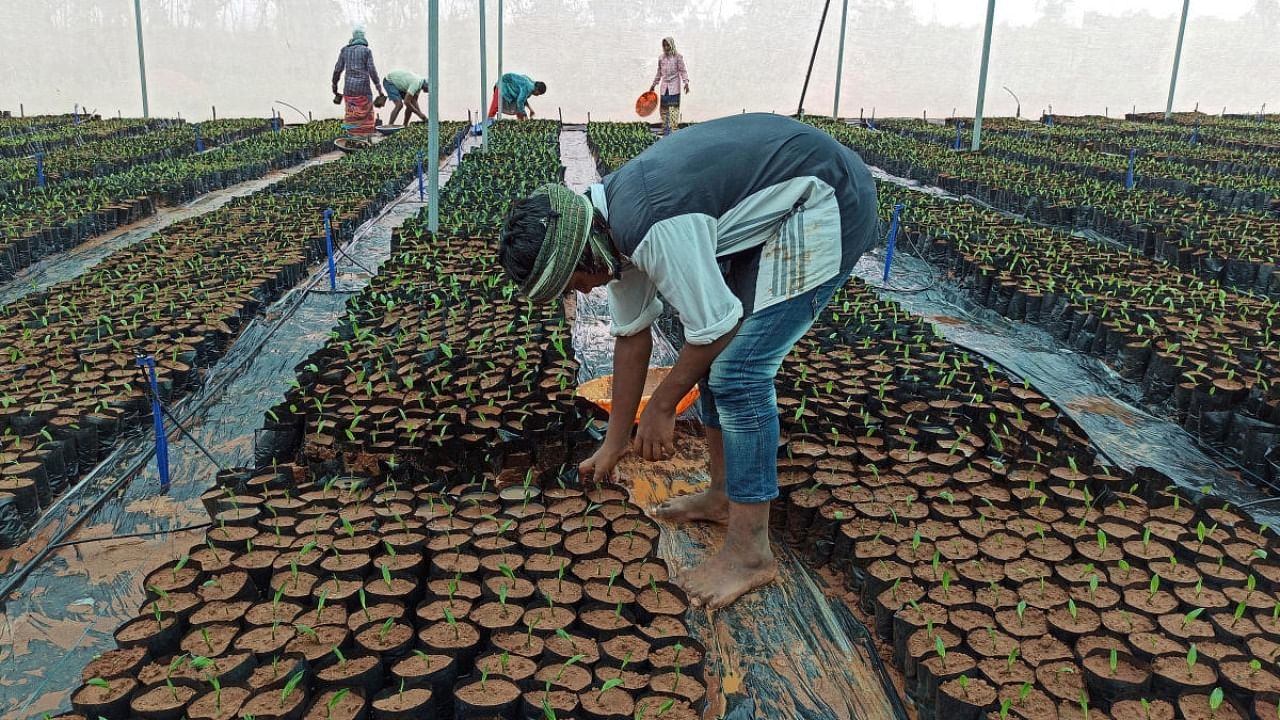
Pullarao Daravathu and thousands of fellow farmers from Telangana are busy planting oil palms as their home state aims to add more area under the controversial crop within four years than the entire country has in decades.
Telangana is targeting 2 million additional acres under oil palm cultivation in the next four years, and is going to great lengths to achieve this goal - from building large dams and irrigation canals to importing millions of germinated sprouts.
Generous government subsidies and bumper profit potential compared to other crops are also encouraging farmers like Daravathu to shift to oil palms.
"Oil palm is giving more than Rs 2 lakh ($2,536) per acre return to farmers who planted the crop some years back. In rice, I am struggling to earn Rs 40,000 even after putting in lots of effort," said Daravathu, who was planting oil palm on his 5-acre farm at Sathupally, nearly 300 km (186 miles) east of Hyderabad, the state capital.
The recent rally in palm oil prices has more than doubled prices of fresh fruit bunches, which farmers sell to oil mills.
For years, price volatility, water scarcity and a gestation period of nearly four years limited oil palm plantation in India to less than 1 million acres, mostly in Andhra Pradesh, the state that Telangana was carved out of in 2014. But Telangana, which occupies an inland region on the Deccan Plateau, is now keen to emerge as India's main palm oil hub, with an area target that would place the state as the fifth largest oil palm grower globally – from a negligible base currently.
The drive could reduce India's mammoth vegetable oil imports, which cost the country a record $18.9 billion a year ago and widened the national trade deficit.
India fulfils two-thirds of its vegetable oil demand through imports of around 14 million tonnes annually, including around 8.5 million tonnes of palm oil.
The federal government is keen to increase palm oil output to slash those expensive imports, which lifted inflation this year to multi-year highs after top supplier Indonesia abruptly halted exports.
"In the next four years, most of the palm planting would be done, and after 7-8 years Telangana could be producing 4 million tonnes of palm oil," L Venkatram Reddy, director of Horticulture at the state government told Reuters.
India currently produces less than 300,000 tonnes of palm oil and relies on imports from Indonesia, Malaysia and Thailand to fulfil its requirements.
Even if Telangana manages to grow oil palm on only 1 million acres and produces 2 million tonnes of palm oil, it would be a huge achievement, said Chava Venkateswara Rao of Godrej Agrovet Ltd, the country's biggest palm oil producer.
Until last year, the country was adding around 35,000 acres under oil palm every year.
Water first
Some areas in Telangana have sufficient water for thirsty oil palms thanks to the rivers such as the Godavari, Krishna and Bhima. But many pockets lacked sufficient water to cater to the oil palm's need of up to 265 litres per tree per day.
To overcome that, the state has built massive lift irrigation projects and a canal network that is now allowing farmers to plant oil palms across most of the state.
"We used to face water scarcity in summer season. Now, with the Kaleshwaram lift irrigation project, we have ample water for oil palm," said farmer Bollampalli Venkateshwar Rao, who planted oil palms on 12 acres.
The Kaleshwaram irrigation project, which is nearly complete, cost the state Rs 1.15 lakh crore ($14.44 billion).
Authorities are giving permission to cultivate oil palms only after farmers install water-conserving micro irrigation systems, said Reddy, adding "The central and state government's subsidies are covering almost the entire cost of drip irrigation system."
The shift towards oil palm from paddy rice and other crops could help the state to bring down annual paddy procurement by around 2.5 million tonnes, and trim the electricity bill for lift irrigation projects by Rs 1,500 crore as drip-fed oil palms need less water than paddy, Reddy said.
Ravi Mathur, who heads the Indian Institute of Oil Palm Research (IIOPR), a government-backed body spearheading the oil palm push, said the lift irrigation project has made oil palm planting feasible in areas previously unsuitable for the crop because of water scarcity.
Planting material scarcity
While thousands of farmers are keen to shift to oil palm, the availability of seedlings is limited, and preparing them is a lengthy process which takes almost a year.
Companies operating in Telangana imported 12.5 million sprouts last year and made seedlings for around 200,000 acres this year, said an official with the state-run TS Oilfed, the country's biggest importer of germinated sprouts
The state is aiming to import 15 million sprouts this year - mainly sourced from Indonesia, Malaysia, Thailand and Costa Rica - and 50 million next year to achieve the target, he said.
But only handful of companies are supplying germinated sprouts.
"There is sudden surge in demand following a rally in palm oil prices. Companies are not able to supply as much we need this year," said Sougata Niyogi, a top official at Godrej Agrovet. "The supply situation would become more comfortable next year."
($1 = 78.8710 Indian rupees)